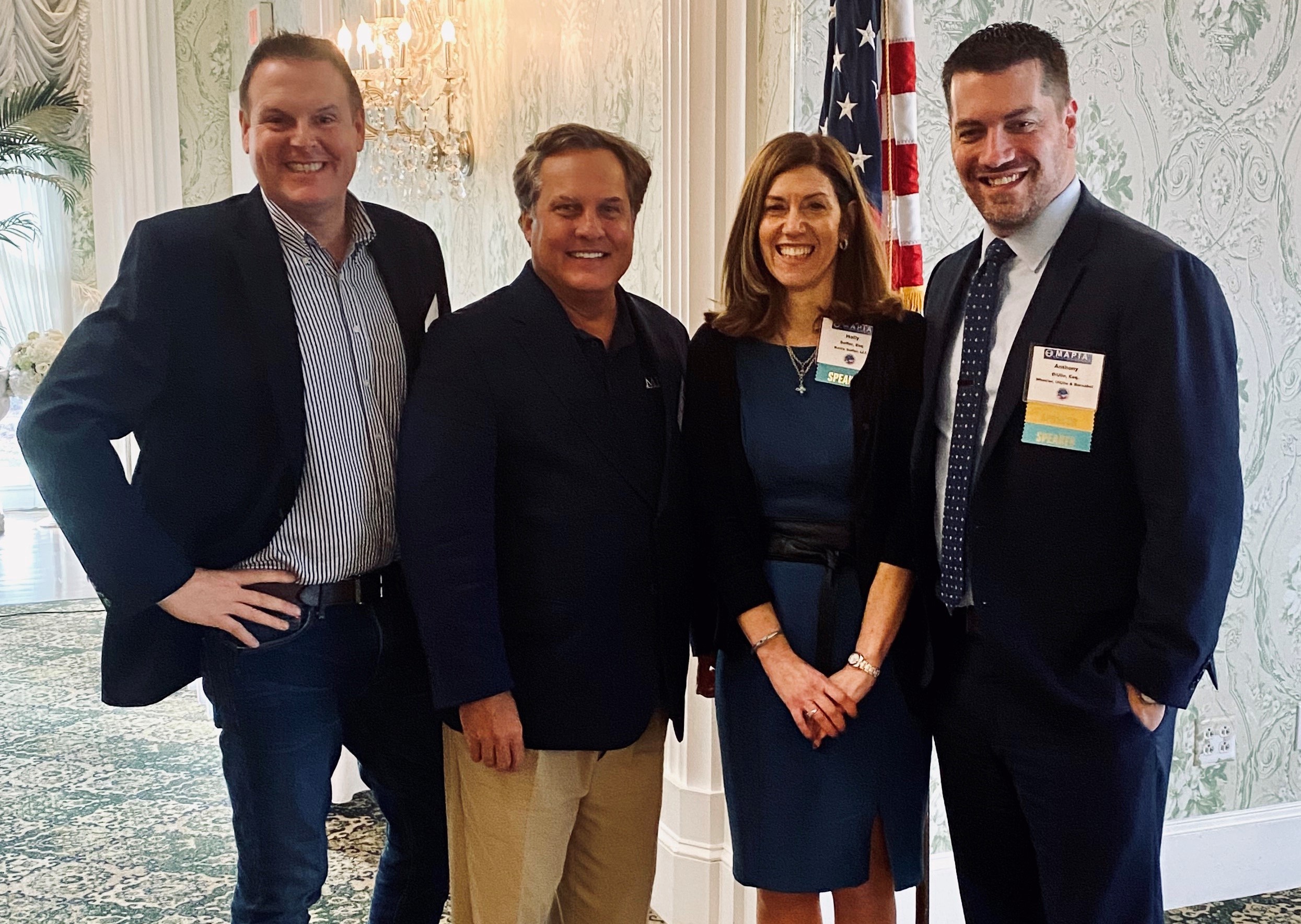The Mid-Atlantic Association of Public Insurance Adjusters (MAPIA) held a meeting this past week with about thirty-five public adjusters in attendance. President Paul Yemm, yours truly, Holly Soffer, and Tony DiUlio are pictured above. Soffer and Diulio gave a wonderful insurance gaps presentation that was highlighted Tony DiUlio’s discussion of a water loss that resulted in a bad faith verdict against State Farm.
The point of the presentation was to highlight the growing insurance gap crisis being caused by insurance companies in a race to compete on price as a result of providing less coverage, which is often never disclosed or highlighted. Regulators and legislators need to step in and address this property insurance gap problem. In the State Farm toilet overflow matter, State Farm actually provided a notice that an endorsement was not made to change coverage while it is obvious the new language provided much less coverage in the typical broken pipe leak situation.
State Farm originally issued a fairly standard “access” coverage which affords coverage for the situations of water losses caused by pipes which break:
If loss to covered property is caused by water or steam not otherwise excluded, we will cover the cost of tearing out and replacing any part of the building necessary to repair the system or appliance. We do not cover the loss to the system or appliance from which the water or steam escaped.
Then with a very misleading notice that said the endorsement was “not intended to change coverage,” State Farm issued this endorsement which clearly reduces coverage in my “access” and plumbing “tear out” cases:
Tear Out. If a Loss Insured to Coverage A property is caused by water or steam escaping from a system or appliance, we will also pay the reasonable cost you incur to tear out and replace only that particular part of the building or condominium unit owned by you necessary to gain access to the specific point of that system or appliance from which the water or steam escaped. We will not cover the cost of repairing or replacing the system or appliance itself.
Tony’s blog points out the predicament from the policyholders’ view:
Imagine you are a homeowner who has received an endorsement that claims it is not changing coverage but, in fact, is giving you additional coverage. Only once you suffer a loss do you discover that your coverage was actually reduced, and you had been deceived by your insurer. That is exactly what happened to the Aguiars….
I go to a lot of insurance conferences and watch a lot of insurance presentations. Tony’s was one of the best of the year. He even noted a small but significant change in the endorsement that no policyholder would catch—-the inclusion of the word “incur.” He correctly noted that carriers are now including this language making the property insurance policy a reimbursement mechanism rather than insurance which will finance the payment of the loss.
Tony obtained a bad faith verdict and was kind enough to provide me with his post-trial brief where he points out the insurance contract is one of adhesion and the relationship between policyholder and insurer:
The goal of interpreting a contract of insurance is to ascertain the intent of the parties through the language of the written instrument….However, because of the “manifest inequality of bargaining power between an insurance company and a purchaser of insurance,” a court may deviate from the plain language of a contract to determine if the contract is one of adhesion. Standard Venetian Blind Co. v. Am. Empire Ins. Co., 503 Pa. 300, 307 (1983). The fundamental nature of a contract of adhesion is such that the consumer who is presented with it has no choice but to either accept the terms of the document as they are written or reject the transaction entirely….’The parties are not of equal bargaining power and the weaker party must adhere to the terms of a form contract which are not negotiable. In other words, the terms are not bargained for, but rather dictated by the insurer.’ Rudolph v. Pa. Blue Shield, 553 Pa. 9, 17 (1998). ‘Once a contract is deemed to be one of adhesion, its terms must be analyzed to determine whether the contract as a whole, or specific provisions of it, are unconscionable.’…If terms of an otherwise enforceable contract are found to be unconscionable, those terms are void.
Water loss claim denials are a growing problem. Insurers are re-writing what have been longstanding coverages that fully paid for the costs associated with pipes which unexpectedly break and cause water damage to the homes and businesses. They are limiting the amounts paid for the damage, shortening the time period from when a leak first ensues and then through other “minor” wording. They are writing policies that would require policyholders to have Superman’s x-ray vision so they can detect leaks behind walls, by containing notice requirements that specifically indicate hidden water leaks will not extend the time for giving notice of the hidden leak!
Since numerous restoration contractors and public adjusters show me examples of people being duped into not having what used to be standard coverage, I want to applaud United Policyholders, the American Association of Public Insurance Adjusters, Nancy Dominguez and the leadership of the Florida Association of Public Insurance Adjusters, Jesse Sipe and the leadership of the Professional Public Adjusters Association of New Jersey, MAPIA, and the Rutgers Center For Risk and Responsibility for actively meeting with insurance regulators and legislators over these issues and educating them about the crisis.
I went with the leadership of the PPAANJ to meet with New Jersey’s Insurance commissioner and her staff over these issues several weeks ago. As you read this, Holly Soffer is in Austin, Texas, meeting with officials of the National Association of Insurance Commissioners about what can be done to correct this plague of uninsured water losses caused by recent changes in what were standard all-risk insurance policies. The Philadelphia Enquirer thinks the gap issue is important enough to have written a story on this case.
These efforts are starting to work, and regulators are starting to listen. The National Coalition of State Legislatures held a webinar on the topic of insurance protection gaps last week and noted:
NCSL is pleased to collaborate with The Institutes Griffith Foundation to present a nonpartisan, non-advocative webinar, which will examine various insurance protection gaps that exist in the property and casualty space and consider what impact these gaps have on consumers and the industry. The primer program will be purely educational and will not take a position on any issues.
The session will provide an introduction to the ‘Lunch and Learn: Insurance Gaps’ session at the 2019 Insurance Task Force meeting, Dec. 12-13, 2019, in Phoenix.
Let’s keep up this good fight for policyholders!
Thought For The Day
I have fought the good fight, I have finished the race, I have kept the faith.
—2 Timothy 4:7




